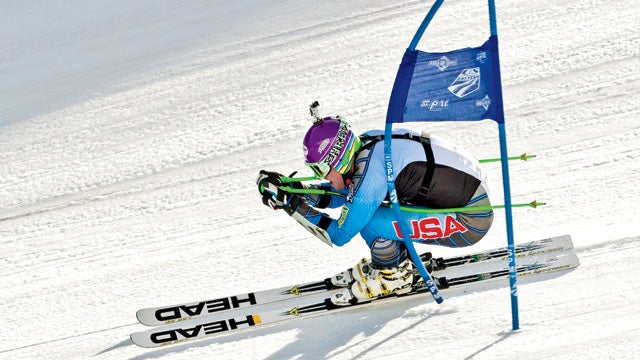IT’S A JULY MORNING in Park City, Utah, and star Ted Ligety, six of his teammates, and I are locked in an intense game of basketball. From the first inbound, Ligety, who is five foot eleven and 185 pounds of power, drives hard, tosses elbows, and blows through picks. ThenÔÇö”Ahhhh!”ÔÇöhe comes down hard on his ankle, turning it over. It starts to swell, and Ligety limps around with clenched teeth, but after ten minutes he shakes off the pain. He has to: the Winter Games in Sochi are only seven months away, and Ligety is expected to contend for numerous medals. There’s a lot of training to do.
Today it’s a brutal circuit of squats, leg presses, hamstring curls, and various balancing exercises. He attacks it ferociouslyÔÇöhis ankle growing largerÔÇöand demands that everybody else follow suit. “Come on, Adam!” he yells at coach Adam Cole, a childhood friend. “Do that exercise one leg at a time!”
When we finish the circuit, Cole and I are drenched and wobbly. Ligety appears relatively fresh. “A third of the way through!” he says, grinning.
With Lindsey Vonn coming off a serious knee injury and Bode Miller in the twilight of his tumultuous career, Ligety, 29, has quietly emerged as the best professional skier in the country. He keeps a significantly lower profile than Vonn or MillerÔÇöyou won’t read about his love life or paternity suits in Vanity FairÔÇöand that’s by design. A hard-charging businessman in his ample downtime, Ligety owes his dominance simply to an immense amount of work.
“I hate the feeling of losing more than I love the feeling of winning,” says the Park City native. “Getting beat all the time and never being the best growing up pushed me to work super hard and forced me to be a student of the sport.”
What separate him from the racing pack in his best event, the giant slalom, are his waterski-like turns, which seem to flip the bird at Newtonian physics. By diving headfirst into a corner and allowing his inside hip and arm to scrape the snow, Ligety is able to prevent his skis from sliding, gaining him precious time over competitors. That ability is the product of thousands of hours of on-the-snow trainingÔÇöand those painful workouts. It’s also the reason some observers think Ligety could win the combined and super-G at the Sochi Games this February and haul in three gold medals, a feat last achieved by Frenchman Jean-Claude Killy, in 1968. The GS, at least, should be a gimme. Over the past year, in events typically decided by hundredths of a second, Ligety won seven of nine World Cup races, some by two to three seconds.
“That’s like a basketball player scoring 150 points or a quarterback throwing eight touchdowns in a game,” Robby Kelley, one of Ligety’s teammates, told NBC last January.
Forest Carey, another of Ligety’s coaches, puts it more succinctly. “Ted figured out a way to ski that nobody has duplicated,” he says.
LIGETY WASN’T born a star. The son of real estate agents, he failed to make the Park City ski team at age nine. He made the squad the following year but spent most of his junior racing career getting beaten.
“He’s incredibly brave, so he was always going full blast,” says Rob Clayton, one of Ligety’s early coaches. “But when he was racing, he’d make mistakes.”
Ligety’s intense training paid off, however, and by the time he was 19, he’d been named to the U.S. Ski Team’s development squad. Two years later, in 2005, he scored four World Cup podiums. More important, he had an epiphany: the elbow turn.
“I started working on angling my body as much as possible, to get the skis to engage earlier,” he says. “Nothing takes more courage than laying your body into a GS turn and committing to it. Now other guys are trying to copy that technique, but it’s not easy to master. And I’ve been doing it since 2005.”
He surprised everybody by winning gold at the 2006 Olympics in Turin, Italy, in the combinedÔÇöa race decided by the times of one downhill run and two slalom runs. Back then he was a relative unknown, and his main sponsor was scrawled on a piece of duct tape stuck to his helmet: Mom + Dad.
That same year, he and a partner started the helmet, goggles, and sunglasses company , which takes its moniker from one of Ligety’s nicknames. (The more popular one is Mr. GS.) These days the company employs 13 people. Sponsors like Citigroup, Coca-Cola, Kellogg’s, and Procter & Gamble have boosted Ligety’s annual skiing-related salary to seven figures, allowing him to afford a sleek, 5,600-square-foot home in Park City that he shares with his girlfriend, Mia Pascoe, but he still keeps his hands on every aspect of Shred’s business. When he’s not on his computer giving final approval on designs, he’s taking conference calls with his sales team or recruiting athletes for sponsorship deals. (Shred is the helmet and goggles supplier for about a third of the U.S. Ski Team.) Every summer, when he’s not training or skiing, he travels the world, checking in on some of the 300 stores that carry his products. Through his efforts, Shred Optics has enjoyed an annual growth rate of 60 percent since its inception, second only to Swedish manufacturer POC in race-helmet and goggles sales. “When I created Shred, I was thinking about the next step, something to do after skiing,” he says.
But Ligety knows that his brand’s success depends in large part on his performance, and he’s fiercely competitive. He’s still smarting over the 2010 Vancouver Olympics, where he was the favorite to win the GS but finished ninth. Then, in the fall of 2011, something happened that he felt threatened to derail his career. Skiing’s governing body, the International Ski Federation (FIS), became concerned that skiers were going too fast and getting hurt too often. The organization mandated that GS competitors use longer, straighter skis instead of the hourglass-shaped ones that allow for easy turns. The rationale was that this would force skiers to skid more, thereby slowing them down. Ligety saw the rule as a direct attack on him and his singular style. He told reporters that the FIS was in cahoots with the underachieving Austrian ski team, and that his sponsor, Head, wouldn’t be able to test and develop a ski in time for that season’s World Cup tour.
“FIS’s tyranny has gone on long enough,” he blogged. “It seems FIS is going out of their way to ruin the sport. FIS runs a dictatorship.” But when it became apparent that FIS wouldn’t budge, Ligety rebooted his training. He switched from the U.S. Ski Team’s program of heavy-lifting sessions to the kind of endurance-building circuits he made me suffer through. “The new skis are so much harder to turn that you get tired toward the end of the course,” he says. “I needed a program that would allow me to still have the energy to make good turns until the finish.”
Now Ligety is focused on capturing the overall World Cup title. To accomplish that, however, he’ll need to start winning in other disciplinesÔÇöthe super-G, slalom, and combined. Last season he took a major step, winning the super-G and combined in addition to the GS at the World Championships in Schladming, Austria. The last skier to do that was also Killy, in 1968.
But World Cup supremacy only resonates with hardcore race fans. The American public cares most about Sochi, where Ligety is looking to make amends for his Vancouver performance. “I felt like I left a lot on the hill, like I was skiing too safe,” he says. “But I learned from that race. Now I attack every course.”
At Mammoth Mountain, California, two months before our workout, I saw this philosophy in practice. A heavy fog rolled over the mountain as Ligety stepped into the start gate for a training run. Ski racers hate fog. It obscures the course’s bumps and rolls and transforms the sport into a game of ACL Russian roulette. Three-quarters of the way down the hill, a group of coaches and ski technicians were placing bets on how much the fog would erode Ligety’s time.
“Two tenths,” said one. “At least three tenths,” said another. “No way,” said Alex Martin, the tech for Head skis and boots. “The difference will be at least half a second.” As Ligety came into view, the group went silent, leaving only the sound of Ligety’s body smacking through the gates. Even in the poor visibility, his turns looked smooth and effortless. When he crossed the finish, Martin checked the time. He was right: the difference was half a second. Half a second faster.


